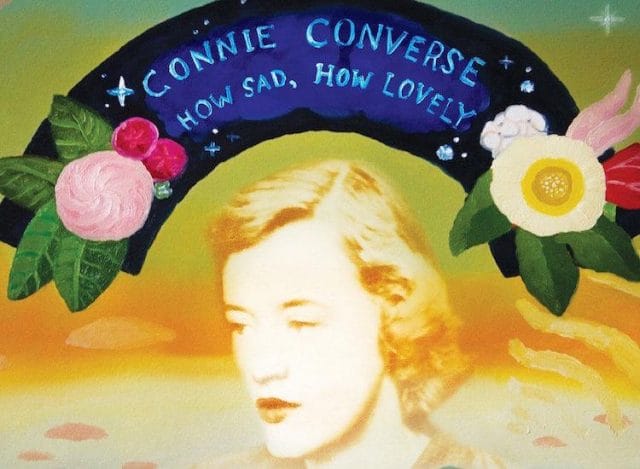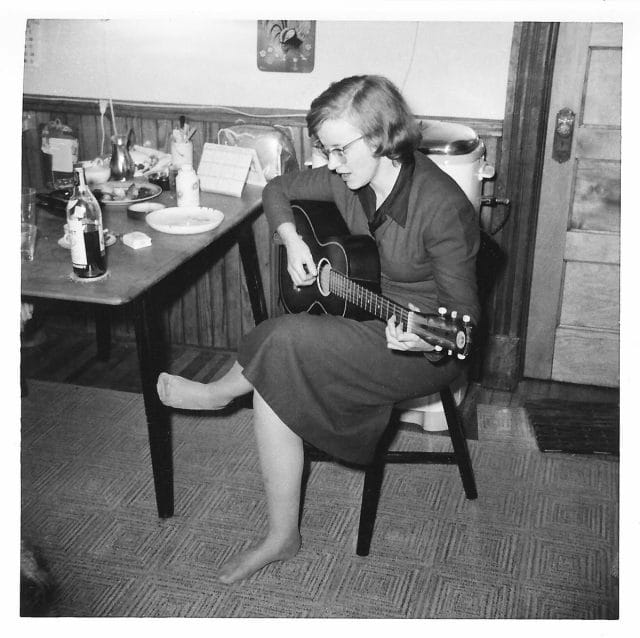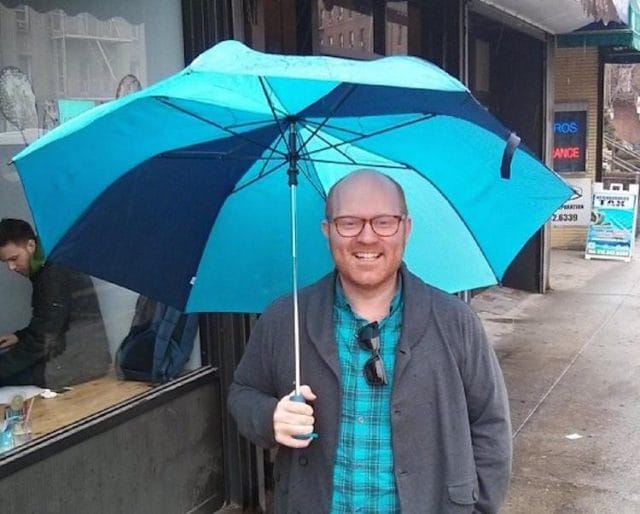
Dan Dzula first heard Connie Converse’s music on NPR in 2004. It was an amateur recording, taken in someone’s kitchen, but he felt an intense emotional connection to the woman behind the song. It was unlike anything he’d ever experienced before.
“I had a very instant read on it,” Dzula remembers. “Her music was so wonderful to me that it just seemed obvious a record would come out soon.”
At the time, Converse was what the music industry calls “undiscovered talent.” She had never released an album, never signed to a label, never even really performed in public. Dzula, a music producer and recording artist making his living in advertising, was sure a record label would snatch her up in no time. When time passed and no album came out, Dzula realized he could produce her.
There was just one problem: nobody knew where Connie Converse was.
And nobody had for a long, long time. One day, she had just packed her life into a Volkswagen bug, sent goodbye letters to her friends and family, and was never heard from again. That was in 1974. She had recorded the tape Dzula heard back in the 1950s.
Converse herself is still lost to the world. Nobody actually knows what became of her. But, thanks to Dan Dzula and his professional partner David Herman, her music is now widely available. You can buy the album, download it, or stream it to your heart’s content, like many, many people before you. Converse is now hailed as both the first American singer-songwriter, and the “indie hipster of the moment.” Converse’s life story — which music journalist Robert Forster called “a drama so sprawling, with a denouement so unexpected, that Hollywood can only gaze in wonder” — has already become the subject of documentary film and stage production. (Forster added, “Reese Witherspoon or Kate Winslet are probably practising the acoustic guitar right now.”)
How was Connie Converse’s work — and the story of her life — rescued from disappearing with her?
A Roving Woman

Connie Converse was born Elizabeth Converse in a small-town in New Hampshire in 1924. By most accounts, she had a conservative upbringing. As music historian David Garland described her parents: “Her father was a strict Baptist minister, her mother was musical.”
A quiet character but a brilliant student, Converse was valedictorian of her high school class. Upon graduating, she attended Mount Holyoke on a full scholarship. Then, two years into her college education, she did what many creative young people still do: she dropped out of college and moved to New York to be an artist.
There, she found work as a printer’s assistant. In her free time, she wrote songs and hounded record labels to listen to them. She was not alone in this pursuit. New York in the 1940s and the 1950s was home to the percolating “folk revival.” The likes of Odetta, Pete Seeger, and Woodie Guthrie played open mics and shuffled through the dark alleys of Greenwich Village, some of them continuing straight on to the national charts.
But “Connie” — a nickname she picked up in New York — was very different from her contemporaries. Most early folk artists sang music other people wrote: old time traditionals and medieval ballads. When they wrote original material, it was more often about America or the environment than about themselves. (With the blacklisting of entertainers, including folk singers, as suspected communists, they had plenty to sing about in that respect.)
“[The folk-based musicians of the ‘50s] were primarily political writers,” music journalist Robert Forster explains, contrasting them with Converse and the generation of songwriters to come. “[N]one foresaw the coming wave of youngsters who would drag poetry and private feelings together to the accompaniment of an acoustic guitar.”
Converse appears to have been a forerunner to the present-day American Songwriter. Her music touched upon her own experience as an intelligent and creative young woman, trying to find love and make a place for herself in mid-Century America. Though many of her songs are humorous, the characters in them are lonely, unfulfilled, or somehow misfit to society’s norms: A free-wheeling man who gallops into town on his brother’s wedding day and may or may not sire the bride’s child in the last verse. A character living happily alone reminisces about a rocky love affair. A woman who likes to go to bars and gambling dens to be “saved” from sin by someone “taking her home.” Many of the songs subtly subvert McCarthy’s conservatism, and, for that matter, Converse’s parents’.
From the song, ‘Roving Woman’:
“People say a roving woman/Is likely not to be better than she ought to be/When I stray away from where I got to be/Someone always takes me home”
Many of the artists Converse met in New York were fascinated with her and went to pains to help her find a wider audience. Her musician friends encouraged her to perform at parties. Susan Reed, a star of the folk scene, covered her songs on stage. Once a friend even pulled some strings and got her onto the Morning Show with Walter Cronkite.
None of this did anything for Converse’s career. There’s no evidence of a label ever showing any interest in her. Very much the introvert, Converse does not seem to have been particularly adept at self-promotion. But even if she was, the singer-songwriter subgenre of folk music was not even remotely ‘mainstream’ until the 1960s. Converse’s songs, full of humor, passion, pining and poignancy were, tragically, ever-so-slightly before their time.

Scene from Inside Llewyn Davis, set in 1950s New York. Like Converse, the title character performs mainly at informal, private events
In the Coen Brothers’ film, Inside Llewyn Davis, a late 1950’s singer songwriter finds himself in a similar situation. He plays his songs in cafes and bars, hustles his way through the music business, lives on frighteningly tight margins, and drifts aimlessly through winter in New York. He’s undeniably talented: time stops when he sings, or at least the camera fixes on him in perfect, otherworldly light. But he gets nowhere. The film ends with a soon-to-be-famous Bob Dylan playing an open mic at Llewyn’s regular bar, off-screen. Meanwhile Llewyn is in the alley outside, getting beat up for the second time in the movie — seemingly forever trapped in the ‘50s.
This seems to have been, essentially, Converse’s experience of New York: she and her songs slogged their way through 1950s New York, completely unnoticed by the music industry. In 1961, the year Dylan moved to Greenwich Village, Converse moved out. She put away her guitar and left New York for Michigan, to live near family.
In Ann Arbor, she got a “real” job, first as a secretary. Eventually, she became managing editor of a research journal: The Journal of Conflict Resolution. It should have been a challenging role for someone who never completed her Bachelor’s degree, but Converse excelled. Calling herself an “educated layman,” she even wrote a few articles herself, which you can read in the Journal’s archives.
Despite her professional success, depression started to eat away at Converse. Finally, in 1974, she disappeared. Her family was distraught. Ultimately, when their search efforts proved futile, and years passed without any contact from her, they decided to respect her right to disappear. Converse was a heavy drinker and smoker at the time. If she survives today she is in her early ‘90s. Her younger brother, Phil Converse, has said he suspected she took her own life back in the 1970s.
Upon her disappearance, Converse had sent letters to her friends and family and left behind notes explaining her decision. In one of them, she pleaded, “Let me go. Let me be if I can. Let me not be if I can’t. […] Human society fascinates me & awes me & fills me with grief & joy; I just can’t find my place to plug into it.”
The Cartoonist Who Captured Connie Converse

Connie practicing at home, 1956
And that is where the story could have ended. But it didn’t. Back when Connie Converse wasn’t making records or performing in public, but making music all the same, somebody happened to record her. And this recording was improbably carried into the 21st century, where it eventually flourished.
Back to New York City, 1955. At a party, a man named Gene Deitch met a strikingly buttoned-down young woman with a guitar. She didn’t seem the sort to normally hang out with his beatnik, bohemian crowd. “I had the immediate impression when I saw her,” Deitch has said, “‘This is the type of person who you usually see as a nun.’”
“But then when she started singing you realized she was anything but a nun.”
The woman was Connie Converse. Deitch has written about the meeting on his personal website:
“When she started to sing, she transformed us! No, she didn’t sing jazz or blues – she sang her own songs, which she was actually composing just at the time. Most were songs of loneliness, rejection, betrayal, often told with ironic humor. They were all-musicianly, beautifully melodic, with seemingly coded lyrics. They completely hypnotized us.”
Dietch was a self-described “recording enthusiast.” He owned a tape-recorder and liked to record musical artists “just for the fun of it.” He promptly asked Converse if he could record her, and she obliged. From a radio interview of Dietch:
“I sat her up on a little stool, sort of a kitchen stool which she liked to sit on when she was playing, and put my microphone in front of her, and she just started to sing. And we maybe would ask a couple words or make a few remarks in between songs but she just sang one song after another.”
“She exuded an atmosphere of tremendous intelligence. It was a little bit […] frightening to talk with her […] [N]aturally, […] all of our guests who met her […] wanted to know all about her, but […] she was so obviously intelligent and brilliant that it was really difficult to speak with her without sounding like an idiot.”
“Connie sang, I recorded her, then she disappeared forever!” Deitch laments on his website. “Her songs were all in one way or another about a woman scorned. They were intensely personal and haunting.”

Gene Deitch self portrait, 2007
Flash forward 50 years. Converse has long-since disappeared. Dietsch has been living in Prague since 1959, and has had a very successful career as an animator. He worked on Pop-Eye and Tom and Jerry, and he won an Oscar for the short film Munro — about a 4-year-old who is accidentally drafted into the military. He’s also been quite successful in amateur recording — his collection includes home-tapes of folk legend Pete Seeger and the earliest known recordings of blues musician John Lee Hooker.
In 2004, on a trip to New York, David Garland, host of the NPR show Spinning on Air, invited Dietsch and his son to play some of their favorite records on the radio.
“I suddenly realized,” Dietch writes, “that with the opportunity of Big Apple airtime, I had a chance to sneak in one piece that […] had never ever been played on the radio.”
He selected a song titled “One by One,” the first he ever heard Converse play. He gave it a brief introduction, relating the air of mystery around the artist, mentioning her disappearance. And then? Nothing happened.
“That was it. Show over!” Dietch writes. “I went home.”
But the show wasn’t over. In 1955 Connie sang, and Dietsch recorded her. 19 years later she disappeared forever. 30 years after that he played a song of hers on the radio, and someone else heard it and couldn’t get it out of his head.
Extra-terrestrial Guardian Angel

Dan Dzula
“I was driving on the New Jersey turnpike on a Sunday evening,” Dan Dzula remembers, “and I happened to be listening to Spinning on Air.”
At the time, Dzula was working in New York on commercial music. “I was basically writing and recording advertising jingles,” he says. According to him, he wasn’t a “folk head,” and still isn’t. He was listening to David Garland’s show that particular day because most of the songs Deitch and his son were playing were jazz.
But when Deitch put Connie Converse’s song on, Dzula felt himself — like Deitch’s friends in the 1950s — hypnotized, transformed, haunted.
“It felt in a way very emotionally accessible for me,” Dzula says. What Deitch said of Converse’s life, and disappearance, also touched him. “Just to know we would perhaps never hear anything else of hers, really kind of scared and inspired me at the same time.”
After hearing ‘One by One’ in his car, he went home and recorded the audio playback from the podcast online, which was temporarily available for streaming. Then, he had a file he could listen to over and over again.
“I put it on a few mixtapes for friends,” Dzula says. “And I listened to that recording frequently. I suppose in hopes that, I don’t know, perhaps it would just come to life.”
From ‘One by One’:
“We go walking in the dark/We go walking out at night/And it’s not as lovers go/Two by two, to and fro/We go one by one”
He listened to that bootleg for two years. In that time, he periodically Googled Converse’s name, hoping to catch wind of the album he knew had to be coming. “From [the moment I heard ‘One by One’] I always kind of imagined that someone else would get in touch with Deitch, and put out an album of this woman’s music,” Dzula says. “I wanted to be the first to buy it.”
“I was listening to a broadcast and presumably other people were hearing the same thing,” Dzula tells us, about his assurance a record was coming. “I just couldn’t believe that I was the only person who was really moved by this song. ”
But the music industry didn’t seem to notice Connie Converse: not in the ‘40s, not in the ‘50s, and not in 2004, 2005, or 2006. No matter how long he waited, or what he Googled, Dzula could not find any evidence of an upcoming record.
“Finally, I got bored of waiting,” Dzula remembers. “Maybe it wasn’t happening, maybe somebody else wasn’t making it. I needed to reach out to Gene Deitch to see if I could help.”
Dzula was not a record executive, the type Converse had spent New York years futilely trying to court. He was more like Gene Deitch or Susan Reed: a fellow artist completely fascinated with Converse, shocked that the larger world had not noticed her. But the industry itself had changed in a big way since Converse’s time. Dzula knew that in his world, artists like him could make their own records and get them in front of an audience.
Three years after Deitch’s Spinning on Air appearance, Dzula found an address on his website and emailed him cold. “It was a longshot,” Dzula says. “I didn’t even know if he’d have time for someone like me.”
To Dzula’s shock and delight, Deitch wrote back. Nobody else had contacted him about Converse, ever, and he was eager to help Dzula in any way he could. Just like that, Dzula was in business, with the strangest, most enthusiastic blessing he could have imagined. From Dietch’s email:
“Preserving and presenting Connie’s songs to the world is one of my most intense unrequited dreams! […] It may be that you are an extra-terrestrial, Dan, sent here to rescue the lost spirit of Connie Converse.”
“It was kind of amazing,” Dzula says. “He basically called me his guardian angel from space.”
How Sad, How Lovely

Dzula bore the mantle proudly. He and his professional partner David Herman began work on a record to debut their independent record label: “Squirrel Thing Recordings,” named for a line in a Connie Converse song.
Producing an absent artist is pretty different from producing a contemporary artist. First of all, with Connie Converse gone, there was nobody to record. Dzula and Herman would have to hunt down surviving recordings, and extract an album from them. It turned out that Deitch had a ton of recordings of Connie Converse, but so did Phil Converse, Connie’s younger brother. She used to mail them to him from New York. Dzula and Herman got in touch with him and acquired his recordings.
“At the time that we produced the first CD,” Dzula says, “we had found about 90 recordings of about 35 different songs.”
Now they have twice as many. The corpus expanded whenever Phil turned up a new box in his attic. Connie may have disappeared 40 years ago, but she kept churning out new material. (Phil Converse, a prominent figure in the field of political psychology, passed away in late 2014.)
The second stage of producing the first album was editing. Because Converse never released an official album, she never had to settle on definitive versions of her songs. But Dzula and Herman did. Dzula and Herman paired 35 songs down to 15, selected the best performances of each of them, and then improved the audio as best they could.
“We felt for a first release, we wanted to make it a little bit easy on the listener,” Dzula says. “We leaned towards the songs that had a more immediate appeal in terms of folk music or even pop. She definitely had some really weird songs as well, which we plan to put on later releases.”
Parallel to these decisions, Dzula and Herman embarked on a massive research project into Connie Converse’s life, one that continues to this day. As her biggest fan in the world, Dzula admits he’s interested in learning as much as he can about her, and he expects listeners to share that interest. “Don’t you want to know what happened to her?” he asks.
But there’s another dimension to his research: knowing more also makes him a better producer. It’s a little like he’s the editor of a posthumous novel — he wants to present the songs as closely as possible to how Connie would want them presented. And in order to do that, he needs to get to know Connie. He’s basically reconstructing a person to go along with very, very personal music. Much of what is now known of Converse’s biography comes directly out of his and Herman’s research, which has included extensive interviews with her friends and family.
“Reconstructing a person is a big part of our project,” Dzula says.
Their efforts culminated in the release of “How Sad, How Lovely,” Connie Converse’s debut album, in 2009. The title came from yet another of her songs. As one reviewer quipped:
“Singer-songwriter Connie Converse is the indie hipster of the moment in Brooklyn, the indie hipster capital of the world, and she’s poised to break out beyond the city limits with the release this week of her debut album.”
***

Since then, Dzula, Herman and Deitch have been joined by a growing cult of Connie Converse fans. These people are independent, passionate, and many. Like a Vivian Maier of folk music, the Internet has enabled the rise of Converse’s star, even without Converse around to promote herself. Converse can be found everywhere, from Bandcamp to YouTube to streaming services like Spotify. We now live in an era of Connie Converse webcomics, crowd-funded Connie Converse documentary films, Connie Converse tribute concerts (some of them featuring Cibo Matto’s Miho Hatori), tribute songs, and blogrolls that keep rolling.
Not to mention the many young men and women covering her songs in YouTube videos, adding her work to the canon of Western folk.
“I think she deserves a place at the table with the great 20th Century songwriters,” Howard Fishman has said. Fishman has a musical career of his own, but he is also the author of “A Star Has Burnt My Eye,” a play based on the life and times of Connie Converse. And he’s produced an album of “Connie Converse’s Piano Songs”: songs that Converse never recorded but wrote the melody of and piano accompaniment to in sheet music.
As he has said, “I think her story is a mirror for us [to reflect on] how we [as Americans] define success, and how we treat ‘outsiders’ in our midst.”
It’s still not a full time job, but Squirrel Thing Recordings has become Dzula’s professional passion. When he’s producing a new album, he spends 6 hours a day in the studio. When he’s not, he’s still putting in a couple hours a day on research and communications. He and Herman released a vinyl version of “How Sad, How Lovely,” last year, and are working on future Connie Converse releases. They’ve also added another ‘absent’ artist to their label: Molly Drake, mother to the ‘70s singer-songwriting legend Nick Drake, also deceased, whose own musical talent went unnoticed until recently.
It’s possible that, were the cards stacked differently, Converse’s music could have had just as much success while she was still around to enjoy it. But the fact that it’s been able to, today, is nothing short of remarkable. Society, it seems, has finally found a place for the woman who could never quite find a place for herself. Of this end, no words seem more appropriate than Converse’s own:
How sad, how lovely…how sweet.
***
In our next post, we examine Meetup.com’s data to figure out what hobbies make American cities unique. To get notified when we post it → join our email list.
This post was written by Rosie Cima. You can follow her on Twitter here.



